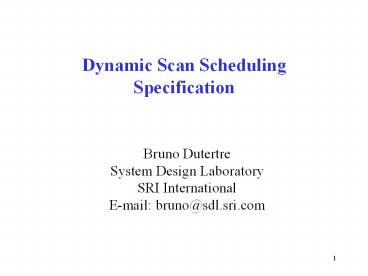Dynamic Scan Scheduling Specification - PowerPoint PPT Presentation
Title:
Dynamic Scan Scheduling Specification
Description:
This gives three sets of constraints on the scan schedule: ... Analysis of scan-schedule performance. Metrics for evaluation of pattern-based schedules ... – PowerPoint PPT presentation
Number of Views:34
Avg rating:3.0/5.0
Title: Dynamic Scan Scheduling Specification
1
Dynamic Scan Scheduling Specification
- Bruno Dutertre
- System Design Laboratory
- SRI International
- E-mail bruno_at_sdl.sri.com
2
Dynamic Scan Scheduler
External Parameters
Performance Requirements
Schedule Construction
Assessment
Scan Schedule
EW Receiver
Signal Data Processing
Detected Pulses
Detected Emitters
- Assessment function
- determines when rescheduling is required
- specifies requirements for the new schedule
- Schedule-construction function
- generates a schedule that meets the requirements
- under real-time constraints
3
DSS Specification
- Objective
- Determine requirements for the schedule-constructi
on function (on a single platform) - Key Issues
- Schedule representation
- Metrics for expressing performance requirements
and measuring schedule performance
4
Schedule Representation
- Strongly periodic schedules
- Defined by pairs dwell time/revisit time for each
frequency band - Feasibility results show that this is too
restrictive - Pattern-based schedules
- Defined by a basic pattern repeated periodically
- The pattern describes a finite list of successive
dwell intervals
Dwell interval
Pattern
5
Performance Metrics
- Two emitter types
- Search and track radars produce successive
illuminations (rotating beams) - Missile radars continuously illuminate their
target - In both cases, detection and tracking require
intercepting a minimal number M of pulses in a
single dwell - Good performance requires a high probability of
intercepting M or more pulses in dwell intervals
6
Periodic-Illumination Emitters
- First Metric Coverage
- The probability of intercepting at least M pulses
from a single illumination
?, m emitter parameters L, n, A parameters
derived from the schedule pattern
This gives an estimate of how well the schedule
does at detecting an illumination from an emitter
not already detected
7
Extensions of Coverage
- The previous metric can be generalized to
- Coverage with respect to successive illuminations
(probability of detecting an emitter after a few
illuminations) - Relative coverage estimate of how good the
schedule is for tracking already detected
emitters (uses information about the likely time
of occurrence of future illuminations) - Probabilistic coverage to deal with emitters
whose characteristics are not known with
exactitude, but with some probability
distribution - All these metrics can be computed from the
schedule pattern
8
Metric for Continuous Emitters
- Requirements for continuous emitters
- A good schedule must minimize detection delays
- Associated metric
- Expected delay between the activation of the
emitter and the interception of at least M pulses
in a single dwell
? pulse repetition interval of the emitter L,
n, parameters derived from the schedule
pattern
9
Global Performance Constraints
- We can partition emitters in two classes
- Emitters already detected (that need to be
tracked) - Emitters likely to be present (that need to be
searched for) - This gives three sets of constraints on the scan
schedule - Tracking constraints maximize the relative
coverage for each tracked emitter - Searching constraints for continuous emitters
minimize the expected detection delay for each
probable emitter - Searching constraints for periodic emitters
maximize coverage for each probable emitter
10
Conclusion
- New results
- Analysis of scan-schedule performance
- Metrics for evaluation of pattern-based schedules
- Requirements for a schedule-construction
algorithm - Future work
- Algorithm development and experimentation
- Extension to the multi-platform case































